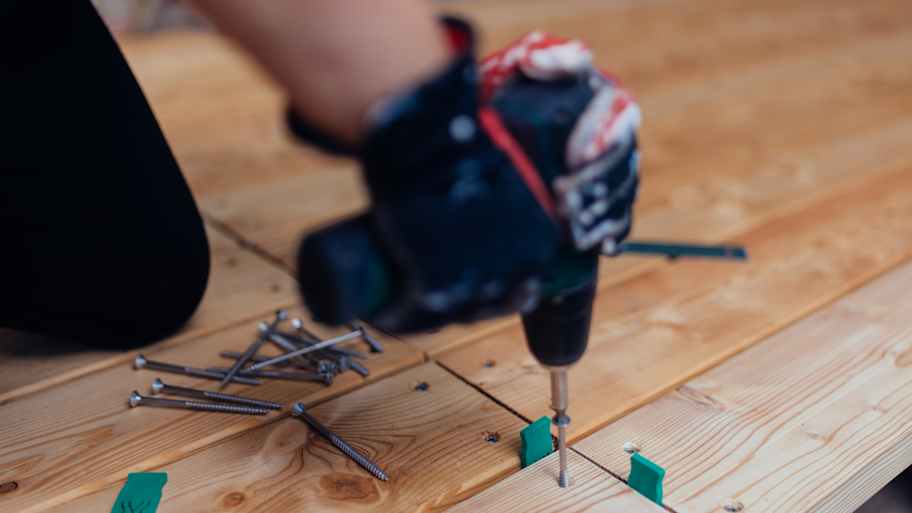
Vinyl is a durable and relatively inexpensive choice of decking material. Your vinyl deck cost will depend on labor, the deck size, and more.
Nail down your decking measurements


The square footage of your deck determines the amount of decking you need.
The size of your deck boards also influences the amount of decking you should buy.
When ordering decking, it’s smart to order 10% extra material to account for waste and cuts.
With this information, you can use a formula to calculate your decking needs.
Dreaming of a new deck? Before you start envisioning your future BBQs and backyard parties, there are a few logistics to sort out, including how much decking you need. With a few measurements and this deck calculator, you can easily figure out the right amount of decking to order.
The amount of decking you need depends on the total square footage of your deck and the size of your deck boards. We also recommend purchasing 10% more material than you need to account for wastage, cutting, and potential mistakes.
We’ll dive deeper into those factors shortly, but here’s a glance at the number of 5.5-inch-thick, 12-foot-long deck boards you’d need for different-sized decks:
| Deck Dimensions | Deck Square Footage | Number of Deck Boards |
|---|---|---|
| 10’ x 12’ | 120 | 24 |
| 12’ x 12’ | 144 | 29 |
| 12’ x 16’ | 192 | 39 |
| 12’ x 20’ | 240 | 48 |
| 14’ x 20’ | 280 | 56 |
| 16’ x 20’ | 320 | 64 |
| 20’ x 20’ | 400 | 80 |
| 20’ x 24’ | 480 | 96 |

If you know the size of your deck and the dimensions of the deck boards, plug them into this formula to determine how much decking you need:
Number of Deck Boards Needed = (Total Deck Square Footage / Individual Deck Board Square Footage) x 1.1
As an example, let’s say you’re building a 12-by-12-foot deck and want to use 5.5-inch-thick deck boards. Here’s how to calculate how much decking you need:
Divide the deck board’s width by 12 to convert it from inches to feet. A 5.5-inch board is 0.46 feet.
Find the square footage of one deck board by multiplying the length and width. For a 5.5-inch board that’s 16 feet long, that’s 5.52 square feet.
Divide the deck’s square footage (144) by a deck board’s square footage (5.52) to get 26.09.
To account for 10% overage, multiply that by 1.1. This gives you 28.7.
Since you can’t buy 0.7 of a deck board, round up to 29 boards.
You’ll need to get your deck’s measurements before buying decking. Here’s how to do that, depending on your circumstances:
If you’re replacing an existing deck, measure the current length and width of the deck. Then, multiply them to find the square footage.
If you’re building a new deck, you’ll decide on your deck’s dimensions during the planning process.

Planning a deck is a big undertaking, and calculating how much decking you need is just one part of the job. Before you can break ground on your new deck, you’ll also have to map out the deck’s layout, choose a decking material, check your local building codes and HOA regulations, and obtain permits.
With that said, there are advantages to designing and building your own deck. By going it alone, you’ll save $15 to $35 per square foot in labor. For a 16-by-20-foot deck, that’s $4,800 to $11,200.
While those savings might sound tempting, this type of work is best left to those with carpentry skills and an understanding of deck-building codes. If that’s not you, your best bet is to hire a decking contractor who can ensure that your deck is safe, sturdy, and legally compliant.
From average costs to expert advice, get all the answers you need to get your job done.

Vinyl is a durable and relatively inexpensive choice of decking material. Your vinyl deck cost will depend on labor, the deck size, and more.

Trellises are structural pieces that add to your garden, but they can also add to your bills. Keep reading to find out how much a trellis costs to build.

Flagstone patio costs vary by the size, material type, labor, and more. Stay tuned to see how much your flagstone patio could cost.

Homeowners may wonder what to put under a deck for moisture. Avoid potential issues for your home’s foundation by protecting the area—here’s what to put under decks for moisture.

Learn how to replace a deck railing with this step-by-step guide, including required tools, material costs, safety tips, and when to hire a professional.

Not sure what deck size you need? Learn about standard deck sizes and what factors to consider to get the right dimensions for backyard bliss.